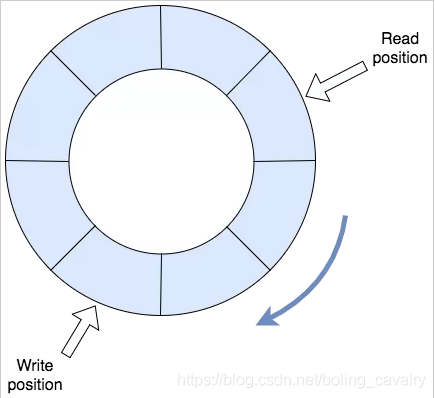disruptor 笔记之一:快速入门
作为《disruptor 笔记》系列的开篇,本篇有两个任务:
创建名为 disruptor-tutorials 的 gradle 工程,作为整个系列的父工程,该系列所有代码都是这个父工程下的 module;
在 disruptor-tutorials 下面新建名为 basic-event 的 module,这是个 springboot 应用,作用是使用 disruptor 的基本功能:一个线程发布事件,另一个线程消费事件,也就是对环形队列最基本的操作,如下图:

[](()用 disruptor 实现消息的发布和消费的套路
咱们提前小结用 disruptor 实现消息的发布和消费的套路,后面的开发按部就班即可,括号中是本篇对应的 java 类:
事件的定义:一个普通的 bean(StringEvent.j 《一线大厂 Java 面试题解析+后端开发学习笔记+最新架构讲解视频+实战项目源码讲义》无偿开源 威信搜索公众号【编程进阶路】 ava)
事件工厂:定义如何生产事件的内存实例,这个实例刚从内存中创建,还没有任何业务数据(StringEventFactory.java)
事件处理:封装了消费单个事件的具体逻辑(StringEventHandler.java)
事件生产者:定义了如何将业务数据设置到还没有业务数据的事件中,就是工厂创建出来的那种(StringEventProducer.java)
初始化逻辑:创建和启动 disruptor 对象,将事件工厂传给 disruptor,创建事件生产者和事件处理对象,并分别与 disruptor 对象关联;
业务逻辑:也就是调用事件生产者的 onData 方法发布事件,本文的做法是在单元测试类中发布事件,然后检查消费的事件数和生产的事件数是否一致;
[](()环境信息
《Disruptor 笔记》系列涉及的环境信息如下:
操作系统:64 位 win10
JDK:1.8.0_281
IDE:IntelliJ IDEA 2021.1.1 (Ultimate Edition)
gradle:6.7.1
springboot:2.3.8.RELEASE
disruptor:3.4.4
[](()源码下载
本篇实战中的完整源码可在 GitHub 下载到,地址和链接信息如下表所示(https://github.com/zq2599/blog_demos):
| 名称 | 链接 | 备注 |
| :-- | :-- | :-- |
| 项目主页 | https://github.com/zq2599/blog_demos | 该项目在 GitHub 上的主页 |
| git 仓库地址(https) | https://github.com/zq2599/blog_demos.git | 该项目源码的仓库地址,https 协议 |
| git 仓库地址(ssh) | git@github.com:zq2599/blog_demos.git | 该项目源码的仓库地址,ssh 协议 |
这个 git 项目中有多个文件夹,本次实战的源码在 disruptor-tutorials 文件夹下,如下图红框所示:

[](()创建父工程
因为是系列文章,所以这里做个父工程来管理所有依赖库和插件,新建名为 disruptor-tutorials 的 gradle 工程,build.gradle 如下:
import java.time.OffsetDateTime
import java.time.format.DateTimeFormatter
buildscript {
repositories {
maven {
url 'https://plugins.gradle.org/m2/'
}
// 如果有私服就在此配置,如果没有请注释掉
maven {
url 'http://192.168.50.43:8081/repository/aliyun-proxy/'
}
// 阿里云
maven {
url 'http://maven.aliyun.com/nexus/content/groups/public/'
}
mavenCentral()
}
ext {
// 项目版本
projectVersion = '1.0-SNAPSHOT'
// sprignboot 版本 https://github.com/spring-projects/spring-boot/releases
springBootVersion = '2.3.8.RELEASE'
}
}
plugins {
id 'java'
id 'java-library'
id 'org.springframework.boot' version "${springBootVersion}" apply false
id 'io.spring.dependency-management' version '1.0.11.RELEASE'
id 'net.nemerosa.versioning' version '2.14.0'
id 'io.franzbecker.gradle-lombok' version '4.0.0' apply false
id 'com.github.ben-manes.versions' version '0.36.0' // gradle dependencyUpdates
}
// If you attempt to build without the --scan parameter in gradle 6.0+ it will cause a build error that it can't find
// a buildScan property to change. This avoids that problem.
if (hasProperty('buildScan')) {
buildScan {
termsOfServiceUrl = 'https://gradle.com/terms-of-service'
termsOfServiceAgree = 'yes'
}
}
wrapper {
gradleVersion = '6.7.1'
}
def buildTimeAndDate = OffsetDateTime.now()
ext {
// 构建时取得当前日期和时间
buildDate = DateTimeFormatter.ISO_LOCAL_DATE.format(buildTimeAndDate)
buildTime = DateTimeFormatter.ofPattern('HH:mm:ss.SSSZ').format(buildTimeAndDate)
buildRevision = versioning.info.commit
}
allprojects {
apply plugin: 'java'
apply plugin: 'idea'
apply plugin: 'eclipse'
apply plugin: 'io.spring.dependency-management'
apply plugin: 'io.franzbecker.gradle-lombok'
compileJava {
sourceCompatibility = JavaVersion.VERSION_1_8
targetCompatibility = JavaVersion.VERSION_1_8
options.encoding = 'UTF-8'
}
compileJava.options*.compilerArgs = [
'-Xlint:all', '-Xlint:-processing'
]
// Copy LICENSE
tasks.withType(Jar) {
from(project.rootDir) {
include 'LICENSE'
into 'META-INF'
}
}
// 写入到 MANIFEST.MF 中的内容
jar {
manifest {
attributes(
'Created-By': "{System.properties['java.vendor']} ${System.properties['java.vm.version']})".toString(),
'Built-By': 'travis',
'Build-Date': buildDate,
'Build-Time': buildTime,
'Built-OS': "${System.properties['os.name']}",
'Build-Revision': buildRevision,
'Specification-Title': project.name,
'Specification-Version': projectVersion,
'Specification-Vendor': 'Will Zhao',
'Implementation-Title': project.name,
'Implementation-Version': projectVersion,
'Implementation-Vendor': 'Will Zhao'
)
}
}
repositories {
mavenCentral()
// 如果有私服就在此配置,如果没有请注释掉
maven {
url 'http://192.168.50.43:8081/repository/aliyun-proxy/'
}
// 阿里云
maven {
url 'http://maven.aliyun.com/nexus/content/groups/public/'
}
jcenter()
}
buildscript {
repositories {
maven { url 'https://plugins.gradle.org/m2/' }
}
}
}
allprojects { project ->
buildscript {
dependencyManagement {
imports {
mavenBom "org.springframework.boot:spring-boot-starter-parent:${springBootVersion}"
mavenBom "org.junit:junit-bom:5.7.0"
}
dependencies {
dependency 'org.projectlombok:lombok:1.16.16'
dependency 'org.apache.commons:commons-lang3:3.11'
dependency 'commons-collections:commons-collections:3.2.2'
dependency 'com.lmax:disruptor:3.4.4'
}
}
ext {
springFrameworkVersion = dependencyManagement.importedProperties['spring-framework.version']
}
}
}
group = 'bolingcavalry'
version = projectVersion
接下来编写消息发布和消费的代码;
[](()新建 module
前面新建了整个《Disruptor 笔记》系列的父工程,现在新建名为 basic-event 的 module,其 build.gradle 内容如下:
plugins {
id 'org.springframework.boot'
}
dependencies {
implementation 'org.projectlombok:lombok'
implementation 'org.springframework.boot:spring-boot-starter'
implementation 'org.springframework.boot:spring-boot-starter-web'
implementation 'com.lmax:disruptor'
testImplementation('org.springframework.boot:spring-boot-starter-test')
}
这个 module 是个 springboot 应用,启动类如下:
package com.bolingcavalry;
import org.springframework.boot.SpringApplication;
import org.springframework.boot.autoconfigure.SpringBootApplication;
@SpringBootApplication
public class BasicEventApplication {
public static void main(String[] args) {
SpringApplication.run(BasicEventApplication.class, args);
}
}
接下来按照前面总结的套路行事;
[](()事件的定义
事件定义类 StringEvent.java,可见就是个普普通通的 java bean:
package com.bolingcavalry.service;
import lombok.Data;
import lombok.NoArgsConstructor;
import lombok.ToString;
@Data
@ToString
@NoArgsConstructor
public class StringEvent {
private String value;
}
[](()事件工厂
事件工厂的作用,是让 disruptor 知道如何在内存中创建一个事件实例,不过,该实例和业务还没有任何关系,本篇的事件工厂如下,可见就是创建 StringEvent 实例,并没有特别的操作:
package com.bolingcavalry.service;
import com.lmax.disruptor.EventFactory;
public class StringEventFactory implements EventFactory<StringEvent> {
@Override
public StringEvent newInstance() {
return new StringEvent();
}
}
[](()事件处理
时间处理类的作用是定义一个事件如何被消费,里面是具体的业务代码,每个事件都会执行此类的 onEvent 方法;
本篇的事件处理类做的事情是打印事件内容,再用 sleep 消耗 100 毫秒,然后再调用外部传入的 Consumer 实现类的 accept 方法:
package com.bolingcavalry.service;
import com.lmax.disruptor.EventHandler;
import lombok.Setter;
import lombok.extern.slf4j.Slf4j;
import java.util.function.Consumer;
@Slf4j
public class StringEventHandler implements EventHandler<StringEvent> {
public StringEventHandler(Consumer<?> consumer) {
this.consumer = consumer;
}
// 外部可以传入 Consumer 实现类,每处理一条消息的时候,consumer 的 accept 方法就会被执行一次
private Consumer<?> consumer;
@Override
public void onEvent(StringEvent event, long sequence, boolean endOfBatch) throws Exception {
log.info("sequence [{}], endOfBatch [{}], event : {}", sequence, endOfBatch, event);
// 这里延时 100ms,模拟消费事件的逻辑的耗时
Thread.sleep(100);
// 如果外部传入了 consumer,就要执行一次 accept 方法
if (null!=consumer) {
consumer.accept(null);
}
}
}
[](()事件生产者
每当业务要生产一个事件时,就会调用事件生产者的 onData 方法,将业务数据作为入参传进来,此时生产者会从环形队列中取出一个事件实例(就是前面的事件工厂创建的),把业务数据传给这个实例,再把实例正式发布出去:
package com.bolingcavalry.service;
import com.lmax.disruptor.RingBuffer;











评论